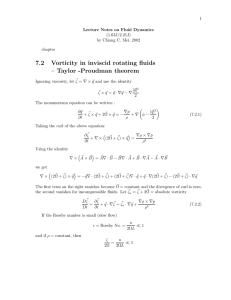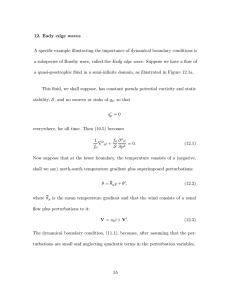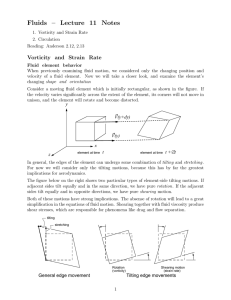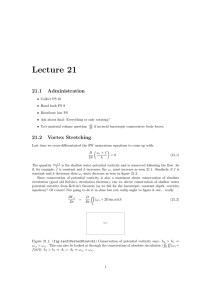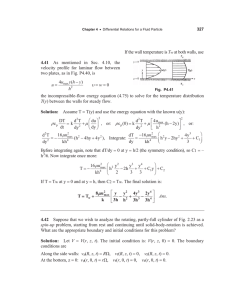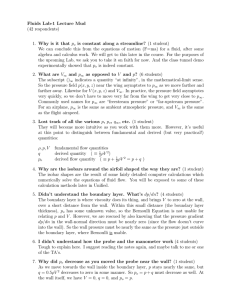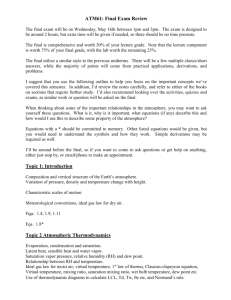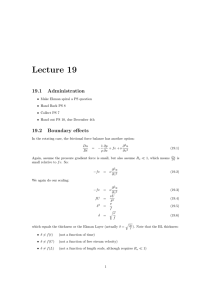Lecture 18 18.1 Administration 18.2
advertisement
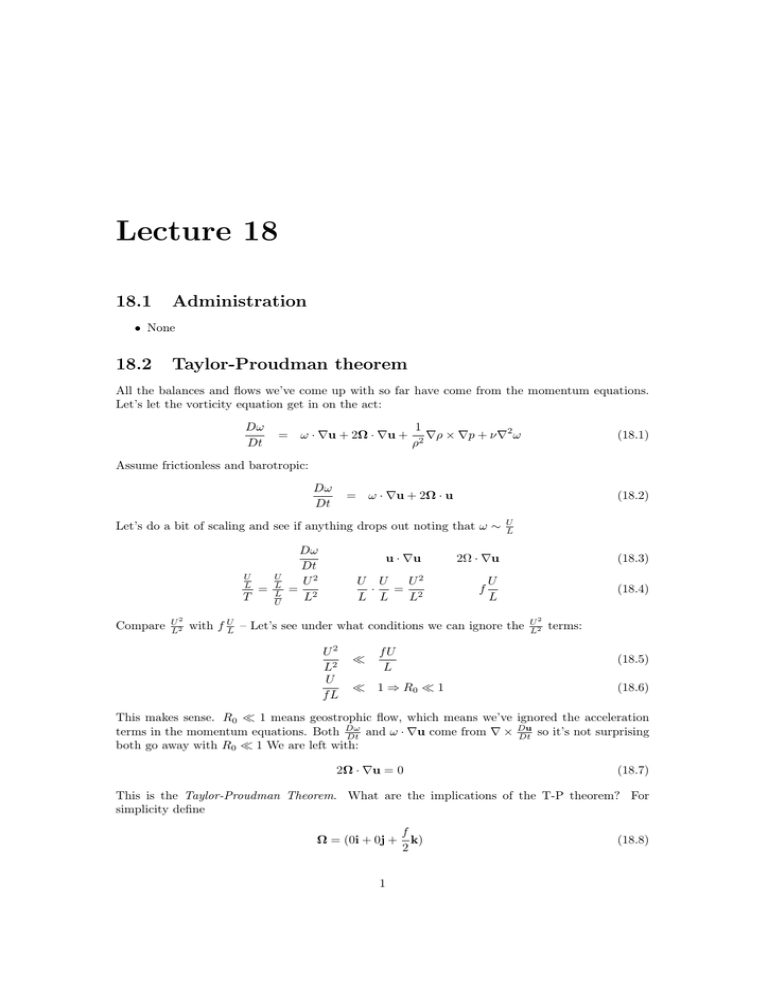
Lecture 18 18.1 Administration • None 18.2 Taylor-Proudman theorem All the balances and flows we’ve come up with so far have come from the momentum equations. Let’s let the vorticity equation get in on the act: Dω Dt = ω · ∇u + 2Ω · ∇u + 1 ∇ρ × ∇p + ν∇2 ω ρ2 (18.1) Assume frictionless and barotropic: Dω Dt = ω · ∇u + 2Ω · u (18.2) Let’s do a bit of scaling and see if anything drops out noting that ω ∼ U L T Compare U2 L2 = U L L U Dω Dt U2 = 2 L u · ∇u U U U2 · = 2 L L L U L 2Ω · ∇u (18.3) U L (18.4) f with f U L – Let’s see under what conditions we can ignore the U2 L2 U fL U2 L2 terms: fU L (18.5) 1 ⇒ R0 1 (18.6) This makes sense. R0 1 means geostrophic flow, which means we’ve ignored the acceleration Du terms in the momentum equations. Both Dω Dt and ω · ∇u come from ∇ × Dt so it’s not surprising both go away with R0 1 We are left with: 2Ω · ∇u = 0 (18.7) This is the Taylor-Proudman Theorem. What are the implications of the T-P theorem? For simplicity define Ω = (0i + 0j + 1 f k) 2 (18.8) Figure 18.1: (fig:Lec18TaylorProudman) Taylor-Proudman – flow around bottom bump. and u = (ui + 0j + 0k) (18.9) Note also strictly speaking we are assuming 2Ωu sin φ is small in addition to frictionless, barotropic, and geostrophic flow. Then: (2Ω · ∇)u ∂ f ∂ ∂ u 2Ωx + 2Ωy +2 ∂x ∂y 2 ∂z ∂ f =u ∂z ∂u ∂z ∂u ∂v ⇒ = ∂z ∂z = 0 (18.10) = 0 (18.11) = 0 (18.12) = 0 (18.13) = 0 (18.14) or more accurately ∂ug ∂vg = =0 ∂z ∂z (18.15) where ug and ug are the geostrophic velocities (true since R0 1). (Q3). This is an extremely neat result. It says that the velocity of the fluid cannot vary in the direction of the rotation vector (assuming slow, steady, frictionless flow of a barotropic fluid). Rotation imposes a vertical rigidity to the fluid: vertical columns of fluid resist being tilted or stretched. Jim’s note to self – show John’s rigidity movies. It gets stranger. Consider the case where we have a rotating, barotropic fluid with a bump on the lower boundary as in figure ??. The fluid at the level of the bump must go around the bump. But because ∂u ∂z = 0 the u and v must be the same at all levels. So at all levels the flow must be deflected as though the bump extends all the way through the fluid. These imaginary or apparent columns are popularly know as Taylor columns. Jim’s note to self – show John’s video. 18.3 Thermal wind All these balances I’ve described so far have been in a barotropic framework (geostrophy with friction might be an exception). What the heck happens if we allow lines of constant pressure to not be parallel to lines of constant density? Let’s go back to the vorticity equation: Dω Dt = ω · ∇u + 2Ω · ∇u + 2 1 ∇ρ × ∇p + ν∇2 ω ρ2 (18.16) Assume frictionless and R0 1: 0 = 2Ω · ∇u + 1 ∇ρ × ∇p ρ2 (18.17) f k) 2 (18.18) For convenience we assume again that: Ω = (0i + 0j + Leaving: 0=2 f ∂u 1 + 2 ∇ρ × ∇p 2 ∂z ρ (18.19) Again for convenience swap ∇ρ and ∇p: 0=2 f ∂u 1 − 2 ∇p × ∇ρ 2 ∂z ρ (18.20) We can do something with that ∇p term from the hydrostatic relationship (the z momentum equation): 0 ⇒ ∂p ∂z = − ∂p − ρg ∂z = −ρg (18.21) (18.22) If we assume that the horizontal gradients of pressure are small relative to the vertical gradients of pressure, then: ∂p k ∂z ∂u 1 ∂p = f − 2 k × ∇ρ ∂z ρ ∂z ∇p = 0 0i + 0j (18.23) (18.24) ∂p is small in this equation but not in the x momentum equation. Substitute Note – it is okay to say ∂x hydrostatic and rearrange: f ⇒ ∂u ∂z ∂u ∂z 1 (ρg)k × ∇ρ ρ2 g = − k × ∇ρ fρ = − (18.25) (18.26) ∂u (Q4). This is the Thermal wind equation. Note – before, ∂u ∂z = 0. Now ∂z = 0 has something to do with gravity and with density gradients. Before we go into why this is called the thermal wind, let’s try and understand what it is saying. Take f back to the LHS: f ∂u ∂z g = − k × ∇ρ ρ (18.27) On the RHS we have gravity trying to flatten sloping density surfaces. This is balanced by the LHS, where vertical shear tilts planetary vorticity resulting in a horizontal vorticity component that maintains the sloping density surfaces. In pictures, this is seen in figures 18.2 and 18.3. I’ll leave it to you to decide if you’d prefer to think of the sloping surfaces generating the vertical shear, or if you’d prefer to think of the vertical shear generating the sloping density surfaces. You 3 Figure 18.2: (fig:Lec18SlopingSurface) Gravity wants to flatten the sloping surface, resulting in a vorticity in the −x direction. Figure 18.3: (fig:Lec18TiltingColumn) The shear tilts the planetary vorticity over (the Taylor column, if you will), and generates vorticity in the tx direction, balancing the vorticity generated by the sloping density surfaces (see also figure 18.4). Figure 18.4: (fig:Lec18ReactionToSlopingSurface) Balance of tilting effects. Figure 18.5: (fig: Lec18PressureLevels) Lines of constant pressure: p1 > p2 > p3 . 4 can also try and understand thermal wind through multi-level geostrophy. Let’s draw lines of constant pressure (see figure 18.5). What I’m trying to show is that the slope of the lines of constant pressure increase with decreasing pressure. You’re going to tell me why in your next problem set. Geostrophy tells us u=− 1 ∂p ρf ∂y (18.28) ∂p (lower pressure levels), the geostrophic wind increases. Thus, the geostrophic wind So for larger ∂y increases with height. So why is it called the thermal wind? ∂u ∂z = − g k × ∇ρ, fρ ρ = f (T ) for example (18.29) We need an equation of state that links density and temperature. Could use ideal gas law of course. But it works for ocean as well. Try: ρ = ρ0 (1 − α(T − T0 )) α T0 ≡ Thermal expansion coefficient ≡ Reference temp (18.30) (18.31) (18.32) Then ⇒ ⇒ ⇒ ⇒ ρ ∂ρ ∂x ∂ρ ∂y ∂ρ ∂z ∇ρ = ρo − ρo αT + ρo αTo ∂T = −ρo α ∂x ∂T = −ρo α ∂y ∂T = −ρo α ∂z = −ρo α∇T (18.33) (18.34) (18.35) (18.36) (18.37) Substitute: ∂u gρo α = k × ∇T ∂z fρ (18.38) Note that the exact form depends on your relationship between P and T . What this says is that it is the horizontal temperature gradients that set up the pressure and density gradients that result in wind shear with height. Draw pix of Hadley exp. on board John’s Hadley video Zonal velocity pictures SST pictures (Figures 18.6, 18.7, 18.8). 18.4 Frictional boundary layer Back to friction and boundary layers. There are a couple different types of boundary layers that are interesting from the 12.800 point of view. The first is the type that reveals a flow: the boundary layer that the atmosphere sees when it is close to the land or the sea, and the type that the ocean sees near the bottom or sides of a basin. 5 Figure 18.6: (fig:Lec18ThermalWindTank) Tank experiment showing thermal wind. Figure 18.7: (fig:Lec18ThermalWindObservations) Observations showing thermal wind. The second is the type that drives a flow: In the ocean, the upper boundary layer is the main source of momentum to drive not only the surface circulation but also the deeper geostrophic circulation. There is a second part of the ocean circulation not covered here... the thermohaline circulation. We’ll have to begin by saying a few thins about boundary layers in general. Consider nonrotating N − S: 2 ∂u 1 ∂p ∂ u ∂2u ∂2u x: (18.39) + + + (u · ∇)u = − +ν ∂x p ∂x ∂x2 ∂y 2 ∂z 2 Consider the case where friction dominates over the pressure force, and there is no variation of u in the x or y direction. The RHS becomes ν ∂2u ∂z 2 (18.40) which can be balanced with some combination of ∂u ∂t The first balance with ∂u ∂t and (u · ∇)u (18.41) – the time dependent problem: ∂u ∂2u =ν 2 ∂t ∂z (18.42) Those of you who have taken a PDE course will recognize this as nothing more than the diffusion equation. We know how to solve this equation (given suitable boundary conditions) using the usual Figure 18.8: (fig:Lec18AnnualMeanSST) Sea surface temperatures. 6 Figure 18.9: (fig:Lec18Shear1) Here, boundary layer thickness grows like Figure 18.10: (fig:Lec18Shear2) Here, steady state solution grows as √ √ T. L. PDE tick of separation of variables (get two ODE’s then find a basis function that satisfies the BC’s... Fourier for this problem typically). But that’s not what I want to talk about. The point I want to make can come from a simple scaling alignment: ∂u ∂t U T ∂2u ∂z 2 U = ν 2 δ = ν (18.43) (18.44) Here δ ≡ boundary layer thickness. So, δ 2 = νT √ δ = νT √ Thus the boundary layer thickness grows like T as seen in figure 18.9. What if we balance with (u · ∇)u? u ∂u ∂t = ν (18.45) (18.46) ∂2u ∂z 2 (18.47) Scaling: U2 U =ν 2 L δ νL δ2 = U L δ= ν U (18.48) (18.49) (18.50) √ This is steady state, but it does say that the steady state solution grows as L (see figure 18.10). This result is consistent with the unsteady result. The time it takes to travel a length L is L T =U , √ L (18.51) δ = ν = νT U So the steady solution for a length L is the same as the unsteady solution at time 7 L U. In the rotating case, the frictional force balance has another option: Du 1 ∂p ∂2u =− + fv + ν 2 Dt ρ ∂x ∂z (18.52) Again assume the pressure gradient force is small, but also assume the Ro 1, which means is small relative to f v. So: −f v fu ∂2u ∂z 2 u = ν 2 α ν ⇒ α ⇒ fixed! f = ν 8 Du Dt (18.53) (18.54) (18.55)
